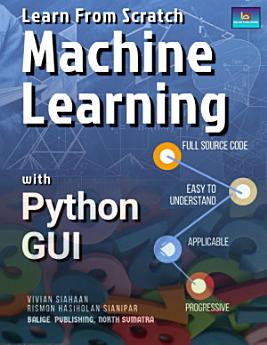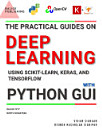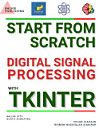LEARN FROM SCRATCH MACHINE LEARNING WITH PYTHON GUI
About this ebook
In Chapter 1, you will learn: Tutorial Steps To Create A Simple GUI Application, Tutorial Steps to Use Radio Button, Tutorial Steps to Group Radio Buttons, Tutorial Steps to Use CheckBox Widget, Tutorial Steps to Use Two CheckBox Groups, Tutorial Steps to Understand Signals and Slots, Tutorial Steps to Convert Data Types, Tutorial Steps to Use Spin Box Widget, Tutorial Steps to Use ScrollBar and Slider, Tutorial Steps to Use List Widget, Tutorial Steps to Select Multiple List Items in One List Widget and Display It in Another List Widget, Tutorial Steps to Insert Item into List Widget, Tutorial Steps to Use Operations on Widget List, Tutorial Steps to Use Combo Box, Tutorial Steps to Use Calendar Widget and Date Edit, and Tutorial Steps to Use Table Widget.
In Chapter 2, you will learn: Tutorial Steps To Create A Simple Line Graph, Tutorial Steps To Create A Simple Line Graph in Python GUI, Tutorial Steps To Create A Simple Line Graph in Python GUI: Part 2, Tutorial Steps To Create Two or More Graphs in the Same Axis, Tutorial Steps To Create Two Axes in One Canvas, Tutorial Steps To Use Two Widgets, Tutorial Steps To Use Two Widgets, Each of Which Has Two Axes, Tutorial Steps To Use Axes With Certain Opacity Levels, Tutorial Steps To Choose Line Color From Combo Box, Tutorial Steps To Calculate Fast Fourier Transform, Tutorial Steps To Create GUI For FFT, Tutorial Steps To Create GUI For FFT With Some Other Input Signals, Tutorial Steps To Create GUI For Noisy Signal, Tutorial Steps To Create GUI For Noisy Signal Filtering, and Tutorial Steps To Create GUI For Wav Signal Filtering.
In Chapter 3, you will learn: Tutorial Steps To Convert RGB Image Into Grayscale, Tutorial Steps To Convert RGB Image Into YUV Image, Tutorial Steps To Convert RGB Image Into HSV Image, Tutorial Steps To Filter Image, Tutorial Steps To Display Image Histogram, Tutorial Steps To Display Filtered Image Histogram, Tutorial Steps To Filter Image With CheckBoxes, Tutorial Steps To Implement Image Thresholding, and Tutorial Steps To Implement Adaptive Image Thresholding. You will also learn: Tutorial Steps To Generate And Display Noisy Image, Tutorial Steps To Implement Edge Detection On Image, Tutorial Steps To Implement Image Segmentation Using Multiple Thresholding and K-Means Algorithm, Tutorial Steps To Implement Image Denoising, Tutorial Steps To Detect Face, Eye, and Mouth Using Haar Cascades, Tutorial Steps To Detect Face Using Haar Cascades with PyQt, Tutorial Steps To Detect Eye, and Mouth Using Haar Cascades with PyQt, Tutorial Steps To Extract Detected Objects, Tutorial Steps To Detect Image Features Using Harris Corner Detection, Tutorial Steps To Detect Image Features Using Shi-Tomasi Corner Detection, Tutorial Steps To Detect Features Using Scale-Invariant Feature Transform (SIFT), and Tutorial Steps To Detect Features Using Features from Accelerated Segment Test (FAST).
In Chapter 4, In this tutorial, you will learn how to use Pandas, NumPy and other libraries to perform simple classification using perceptron and Adaline (adaptive linear neuron). The dataset used is Iris dataset directly from the UCI Machine Learning Repository. You will learn: Tutorial Steps To Implement Perceptron, Tutorial Steps To Implement Perceptron with PyQt, Tutorial Steps To Implement Adaline (ADAptive LInear NEuron), and Tutorial Steps To Implement Adaline with PyQt.
In Chapter 5, you will learn how to use the scikit-learn machine learning library, which provides a wide variety of machine learning algorithms via a user-friendly Python API and to perform classification using perceptron, Adaline (adaptive linear neuron), and other models. The dataset used is Iris dataset directly from the UCI Machine Learning Repository. You will learn: Tutorial Steps To Implement Perceptron Using Scikit-Learn, Tutorial Steps To Implement Perceptron Using Scikit-Learn with PyQt, Tutorial Steps To Implement Logistic Regression Model, Tutorial Steps To Implement Logistic Regression Model with PyQt, Tutorial Steps To Implement Logistic Regression Model Using Scikit-Learn with PyQt, Tutorial Steps To Implement Support Vector Machine (SVM) Using Scikit-Learn, Tutorial Steps To Implement Decision Tree (DT) Using Scikit-Learn, Tutorial Steps To Implement Random Forest (RF) Using Scikit-Learn, and Tutorial Steps To Implement K-Nearest Neighbor (KNN) Using Scikit-Learn.
In Chapter 6, you will learn how to use Pandas, NumPy, Scikit-Learn, and other libraries to implement different approaches for reducing the dimensionality of a dataset using different feature selection techniques. You will learn about three fundamental techniques that will help us to summarize the information content of a dataset by transforming it onto a new feature subspace of lower dimensionality than the original one. Data compression is an important topic in machine learning, and it helps us to store and analyze the increasing amounts of data that are produced and collected in the modern age of technology. You will learn the following topics: Principal Component Analysis (PCA) for unsupervised data compression, Linear Discriminant Analysis (LDA) as a supervised dimensionality reduction technique for maximizing class separability, Nonlinear dimensionality reduction via Kernel Principal Component Analysis (KPCA). You will learn: 6.1 Tutorial Steps To Implement Principal Component Analysis (PCA), Tutorial Steps To Implement Principal Component Analysis (PCA) Using Scikit-Learn, Tutorial Steps To Implement Principal Component Analysis (PCA) Using Scikit-Learn with PyQt, Tutorial Steps To Implement Linear Discriminant Analysis (LDA), Tutorial Steps To Implement Linear Discriminant Analysis (LDA) with Scikit-Learn, Tutorial Steps To Implement Linear Discriminant Analysis (LDA) Using Scikit-Learn with PyQt, Tutorial Steps To Implement Kernel Principal Component Analysis (KPCA) Using Scikit-Learn, and Tutorial Steps To Implement Kernel Principal Component Analysis (KPCA) Using Scikit-Learn with PyQt.
In Chapter 7, you will learn how to use Keras, Scikit-Learn, Pandas, NumPy and other libraries to perform prediction on handwritten digits using MNIST dataset. You will learn: Tutorial Steps To Load MNIST Dataset, Tutorial Steps To Load MNIST Dataset with PyQt, Tutorial Steps To Implement Perceptron With PCA Feature Extractor on MNIST Dataset Using PyQt, Tutorial Steps To Implement Perceptron With LDA Feature Extractor on MNIST Dataset Using PyQt, Tutorial Steps To Implement Perceptron With KPCA Feature Extractor on MNIST Dataset Using PyQt, Tutorial Steps To Implement Logistic Regression (LR) Model With PCA Feature Extractor on MNIST Dataset Using PyQt, Tutorial Steps To Implement Logistic Regression (LR) Model With LDA Feature Extractor on MNIST Dataset Using PyQt, Tutorial Steps To Implement Logistic Regression (LR) Model With KPCA Feature Extractor on MNIST Dataset Using PyQt, Tutorial Steps To Implement , Tutorial Steps To Implement Support Vector Machine (SVM) Model With LDA Feature Extractor on MNIST Dataset Using PyQt, Tutorial Steps To Implement Support Vector Machine (SVM) Model With KPCA Feature Extractor on MNIST Dataset Using PyQt, Tutorial Steps To Implement Decision Tree (DT) Model With PCA Feature Extractor on MNIST Dataset Using PyQt, Tutorial Steps To Implement Decision Tree (DT) Model With LDA Feature Extractor on MNIST Dataset Using PyQt, Tutorial Steps To Implement Decision Tree (DT) Model With KPCA Feature Extractor on MNIST Dataset Using PyQt, Tutorial Steps To Implement Random Forest (RF) Model With PCA Feature Extractor on MNIST Dataset Using PyQt, Tutorial Steps To Implement Random Forest (RF) Model With LDA Feature Extractor on MNIST Dataset Using PyQt, Tutorial Steps To Implement Random Forest (RF) Model With KPCA Feature Extractor on MNIST Dataset Using PyQt, Tutorial Steps To Implement K-Nearest Neighbor (KNN) Model With PCA Feature Extractor on MNIST Dataset Using PyQt, Tutorial Steps To Implement K-Nearest Neighbor (KNN) Model With LDA Feature Extractor on MNIST Dataset Using PyQt, and Tutorial Steps To Implement K-Nearest Neighbor (KNN) Model With KPCA Feature Extractor on MNIST Dataset Using PyQt.
Ratings and reviews
About the author
Vivian Siahaan is a fast-learner who likes to do new things. She was born, raised in Hinalang Bagasan, Balige, on the banks of Lake Toba, and completed high school education from SMAN 1 Balige. She started herself learning Java, Android, JavaScript, CSS, C ++, Python, R, Visual Basic, Visual C #, MATLAB, Mathematica, PHP, JSP, MySQL, SQL Server, Oracle, Access, and other programming languages. She studied programming from scratch, starting with the most basic syntax and logic, by building several simple and applicable GUI applications. Animation and games are fields of programming that are interests that she always wants to develop. Besides studying mathematical logic and programming, the author also has the pleasure of reading novels. Vivian Siahaan has written dozens of ebooks that have been published on Sparta Publisher: Data Structure with Java; Java Programming: Cookbook; C ++ Programming: Cookbook; C Programming For High Schools / Vocational Schools and Students; Java Programming for SMA / SMK; Java Tutorial: GUI, Graphics and Animation; Visual Basic Programming: From A to Z; Java Programming for Animation and Games; C # Programming for SMA / SMK and Students; MATLAB For Students and Researchers; Graphics in JavaScript: Quick Learning Series; JavaScript Image Processing Methods: From A to Z; Java GUI Case Study: AWT & Swing; Basic CSS and JavaScript; PHP / MySQL Programming: Cookbook; Visual Basic: Cookbook; C ++ Programming for High Schools / Vocational Schools and Students; Concepts and Practices of C ++; PHP / MySQL For Students; C # Programming: From A to Z; Visual Basic for SMA / SMK and Students; C # .NET and SQL Server for High School / Vocational School and Students. At the ANDI Yogyakarta publisher, Vivian Siahaan also wrote a number of books including: Python Programming Theory and Practice; Python GUI Programming; Python GUI and Database; Build From Zero School Database Management System In Python / MySQL; Database Management System in Python / MySQL; Python / MySQL For Management Systems of Criminal Track Record Database; Java / MySQL For Management Systems of Criminal Track Records Database; Database and Critptography Using Java / MySQL; Build From Zero School Database Management System With Java / MySQL.
Rismon Hasiholan Sianipar was born in Pematang Siantar, in 1994. After graduating from SMAN 3 Pematang Siantar 3, the writer traveled to the city of Jogjakarta. In 1998 and 2001 the author completed his Bachelor of Engineering (S.T) and Master of Engineering (M.T) education in the Electrical Engineering of Gadjah Mada University, under the guidance of Prof. Dr. Adhi Soesanto and Prof. Dr. Thomas Sri Widodo, focusing on research on non-stationary signals by analyzing their energy using time-frequency maps. Because of its non-stationary nature, the distribution of signal energy becomes very dynamic on a time-frequency map. By mapping the distribution of energy in the time-frequency field using discrete wavelet transformations, one can design non-linear filters so that they can analyze the pattern of the data contained in it. In 2003, the author received a Monbukagakusho scholarship from the Japanese Government. In 2005 and 2008, he completed his Master of Engineering (M.Eng) and Doctor of Engineering (Dr.Eng) education at Yamaguchi University, under the guidance of Prof. Dr. Hidetoshi Miike. Both the master's thesis and his doctoral thesis, R.H. Sianipar combines SR-FHN (Stochastic Resonance Fitzhugh-Nagumo) filter strength with cryptosystem ECC (elliptic curve cryptography) 4096-bit both to suppress noise in digital images and digital video and maintain its authenticity. The results of this study have been documented in international scientific journals and officially patented in Japan. One of the patents was published in Japan with a registration number 2008-009549.
He is active in collaborating with several universities and research institutions in Japan, particularly in the fields of cryptography, cryptanalysis and audio / image / video digital forensics. R.H. Sianipar also has experience in conducting code-breaking methods (cryptanalysis) on a number of intelligence data that are the object of research studies in Japan. R.H. Sianipar has a number of Japanese patents, and has written a number of national / international scientific articles, and dozens of national books. R.H. Sianipar has also participated in a number of workshops related to cryptography, cryptanalysis, digital watermarking, and digital forensics. In a number of workshops, R.H. Sianipar helps Prof. Hidetoshi Miike to create applications related to digital image / video processing, steganography, cryptography, watermarking, non-linear screening, intelligent descriptor-based computer vision, and others, which are used as training materials. Field of interest in the study of R.H. Sianipar is multimedia security, signal processing / digital image / video, cryptography, digital communication, digital forensics, and data compression / coding. Until now, R.H. Sianipar continues to develop applications related to analysis of signal, image, and digital video, both for research purposes and for commercial purposes based on the Python programming language, MATLAB, C ++, C, VB.NET, C # .NET, R, and Java.








